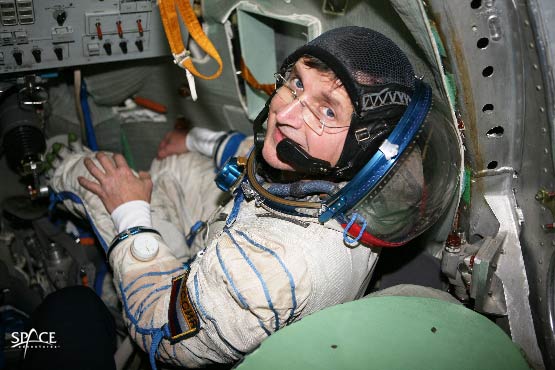Is American Billionaire the Last Space Tourist?

Today's launch of a paying civilian into orbit may be thelast one for some time.
The Russian rockets that have been carryingrich private citizens to space consistently since 2001, through dealsbrokered by the U.S. firm Space Adventures, may soon be booked up byprofessional astronauts.
NASA and its international partners are planning to boost theInternational Space Station (ISS) from hosting crews of three to crews of six spaceflyerssometime this summer. The space population boom could mean that professionalstation astronauts will need every spare seat on the Russian Soyuz spacecrafts,as well as on the up to eight remaining space shuttle flights, that launch tothe orbiting lab.
"It makes it more difficult to obtain flight opportunitieson the missions that are scheduled to rotate crews," Space Adventurespresident Eric Anderson recently told SPACE.com.
American billionaireCharles Simonyi lifted off toward the International Space Station (ISS) thismorning on a Russian rocket, after paying the Russian Federal Space Agency $35million through Space Adventures. The trip is Simonyi's second ? he previouslyflew to the ISS in 2007 ? but could be the firm's last for a couple years.
"I'm actually optimistic, but it's too early totell," Anderson said. "Even with a [space station] crew of six peopleit's conceivable that there might be a couple of seats for commercial purposesfor 2010 or 2011."
However, NASA didn't sound so sure.
Breaking space news, the latest updates on rocket launches, skywatching events and more!
"Today the plan is to fly one more ? it's not atourist, it's a Kazakh-trained crewmember that's been with them for awhile," NASA ISS program manager Mike Suffredini said earlier this month."We'd consider him a crewmember actually, given his experience and thetime he's been in training. That?s to occur this fall, and we've been informedthat will be the last, at least from a planning perspective, that is the lastof the tourists to fly."
To be sure that some opportunities are left open in thefuture, the Vienna, Va.-based Space Adventures plans to book an entire futureSoyuz flight for its clients. Russia?s Soyuz spacecraft are three-personvehicles. During usual space tourist flights, one seat is filled by a payingcustomer, while the other two are filled by professional spaceflyers.
"The objective would be a tourist mission,"Anderson said. "The mission would be paid for entirely by Space Adventuresfor the purposes of tourism."
This flight, which would be piloted by one professional astronautand carry two paying passengers, would not occur until 2011 or 2012.
That reservation may come in especially handy when NASAretires its shuttle fleet in 2010, putting the burden of ferrying astronauts toand from the space station entirely on the Soyuz vehicles.
For Simonyi's part, the Hungarian-born software executiveseems to have fitin his flight just under the wire.
"I'm extremely lucky thatthis particular balance of costs and benefits occurred where it was possiblefor a not ridiculous amount [of money] to participate and contribute," hetold SPACE.com. "These ratios of costs will change, and in the nearfuture I think the costs will increase quite a bit and the availability will godown."
Ultimately, though, Simonyi said the future of private spacetravel is bright.
"Look at Star Trek," he said. "When people watchStar Trek they don?t think that this is impossible. They think it is absolutelynatural, and even necessary. Obviously we're going to get there."
- Video - Space Tourist Charles Simonyi in Zero G
- Images - Charles Simonyi in Space!
- Video - Space Station Acrobatics

Clara Moskowitz is a science and space writer who joined the Space.com team in 2008 and served as Assistant Managing Editor from 2011 to 2013. Clara has a bachelor's degree in astronomy and physics from Wesleyan University, and a graduate certificate in science writing from the University of California, Santa Cruz. She covers everything from astronomy to human spaceflight and once aced a NASTAR suborbital spaceflight training program for space missions. Clara is currently Associate Editor of Scientific American. To see her latest project is, follow Clara on Twitter.
